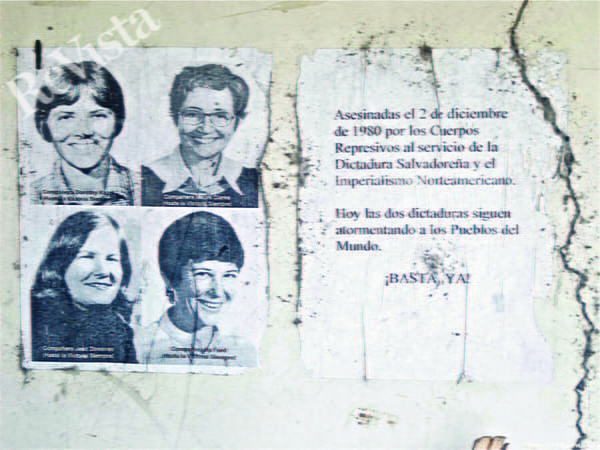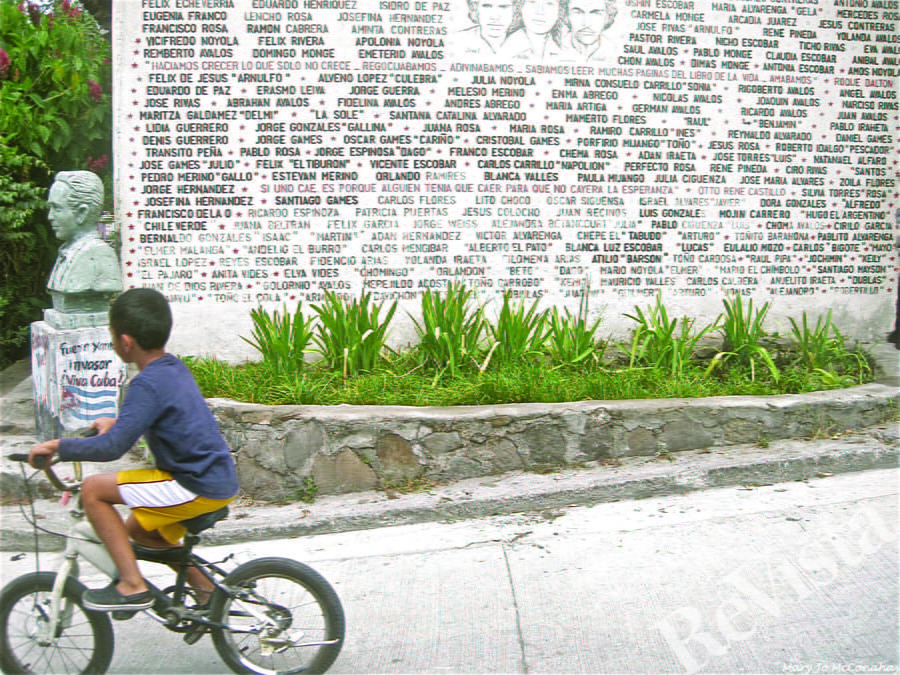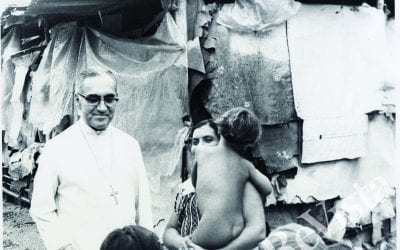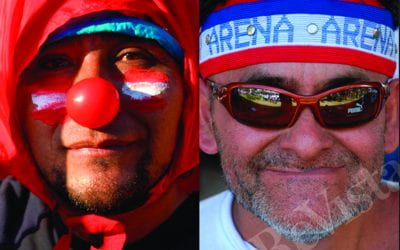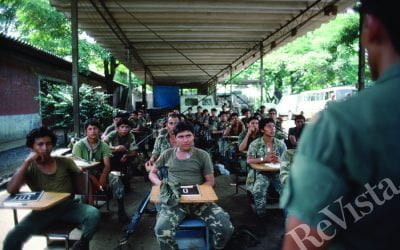Transitional Justice in El Salvador
The Promise and the Pain
On a warm morning in January 2016, in a small town far from the capital in El Salvador’s northern Morazan province, just off the shady central square, an extraordinary hearing is unfolding in a cramped courtroom. Over the low, constant whir of a fan, Justice of the Peace Mario Soto speaks clearly to survivors and relatives of victims of a 1982 army massacre by U.S.-trained forces at a village called El Mozote and nearby settlements. A thousand unarmed civilians, including infants and children, died. Government attorneys, lawyers for the peasants whose families were killed and forensic scientists, listen closely. They are not accustomed to hearing such words from the bench.
“I want to know everything,” says Soto. “What we do here has national transcendence, international transcendence. My decisions will be based on the constitution, and above all on international human rights law.”
Some 75,000 persons, overwhelmingly civilians, died in the civil war between 1980 and 1992, most at the hands of government forces. Adjudicating past crimes, especially war crimes, is arguably one of the most effective ways to strengthen a post-conflict society, lending credence to the judicial system and fortifying the process of transitional justice to underpin a true democracy. But in El Salvador no one is convicted for ordering, or carrying out, massacres like El Mozote, or for assassinations such as those of Archbishop Óscar Romero in 1980 and six Jesuit priests in 1989. There remains no accounting for thousands of disappeared civilians.
That is why the scene in the Meanguera courtroom feels unusual: a judge is pushing for justice in the case of a war crime with every apparent intention of seeking a resolution within El Salvador’s own judicial system, no matter where the evidence leads. Frustrated with roadblocks in the past, lawyers for families of the slain and for survivors of the killings in the hamlets around El Mozote took the case to the Inter-American Court of Human Rights (IACtHR), which found the government responsible. In a 2012 ruling, the court ordered reparations and made other demands that remain unfulfilled. When locals objected to the way a government forensic exhumation was being conducted in the hamlet of La Joya, risking the loss of evidence, they repaired to Judge Soto to stop the exhumation, which he did. Now Soto finds himself in the middle of one of the war’s best-known cases, one which symbolizes the army’s scorched-earth policy that killed thousands of unarmed civilians, a massacre which Washington dismissed at the time as communist propaganda. In the Meanguera courtroom, survivors and family members, some quaking and tearful, claimed harassment and intimidation from government attorneys charged with fulfilling the IACtHR demands. Moreover, distrusting government, they demanded that exhumations be performed by the renowned Argentine Forensic Anthropology Team.
“We are being made victims again,” one woman told the packed room. “I do not understand the justice system, but I know we have a judgment from an international court and we want no more hypocrisy.”
Judge Soto too has encountered roadblocks. In an interview, Soto, 43, said his request for scientific advisers was turned down by superiors, who also denied him all-terrain transport, forcing him to educate himself in libraries on complex technical aspects of the case, and to take the bus to some of its remote sites. One morning he found slipped under his door a piece of paper containing only the license number of his family car, he said, which he took as a personal threat to “judicial independence.”
In court Soto referred to the harassment and “obscene” and “alarming” incidents that have erupted to put “obstacles” before the process so far, which has been limited to elements concerning fulfillment of the IACtHR decision. He said he wants to see “a penal investigation of everything that has happened.” In Meanguera, he ruled that the Argentine team could work with the government’s forensic scientists on future exhumations, a solution that seemed to please all. He welcomed the presence of new government attorneys, giving one he knew well “a vote of confidence,” which survivors said was a relief. The process in Meanguera is not a penal case, but lawyers for victims are encouraged when they see a jurist willing to move forward on an aspect of such a controversial event from the past.
“Many are dying without seeing justice,” said Wilfredo Medrano of the Tutela Legal “María Julia Hernández,” whose lawyers took the El Mozote case to the Inter-American Court. At Meanguera, Medrano referred to the January arrival in El Salvador of former Defense Minister José Guillermo García, extradited from the United States. Last year former Vice-Minister of Defense Nicolás Carranza, who had been on the CIA payroll while in office according to U.S. court testimony, was extradited. Both men were found culpable in U.S. courts for crimes against humanity, torture and murder of civilians. Victims and advocates want to see them tried in El Salvador. “Exhumations are important but we want justice,” said Medrano.
At the end of the emotional session, Judge Soto declared the El Mozote case was going in “a new direction” and survivors agreed; primero Dios, they inevitably added, “God willing.” Soto took to social media in February to invite “the entire nation” to a ceremony at El Mozote, where remains “scientifically” examined by forensic experts were handed over to families.
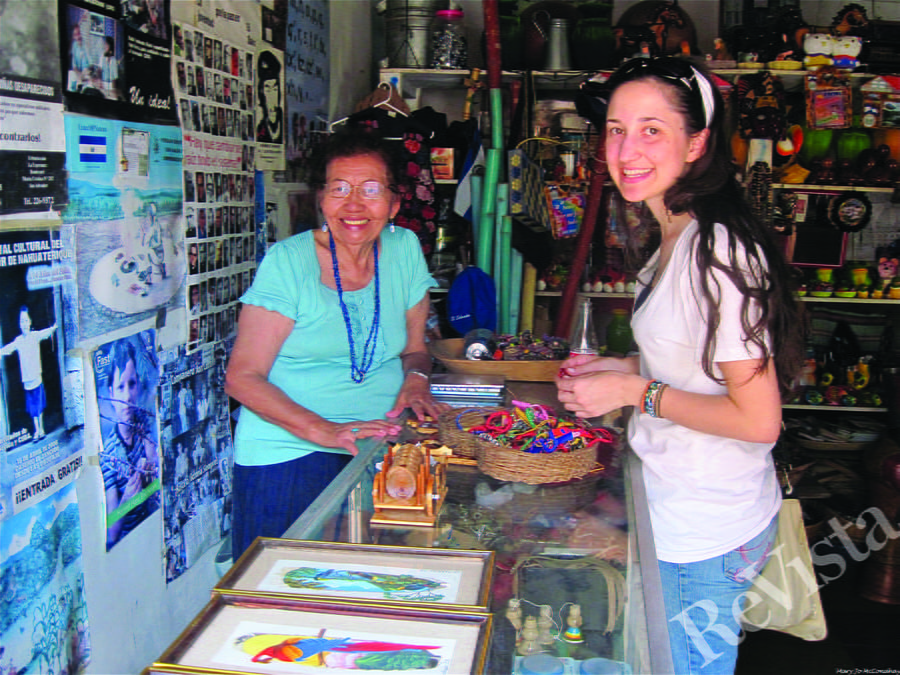
A mother of fallen FMLN combatants chats with an international student on the Peace Route in Perquín, a former guerrilla stronghold. Photo by Mary Jo McConahay.
THE SHADOW OF THE “AMNESTY LAW’
Soto’s declared intent to follow international human rights law is telling, and in El Salvador, unusual. In 1993, just five days after a U.N. Truth Commission laid responsibility for 85 percent of war deaths on the government (and five percent on the rebel forces of the Farabundo Martí National Liberation Front [FMLN]), the rightist-controlled National Assembly declared a blanket amnesty for violence during the armed conflict. The “Amnesty Law” has hung over progress in justice like a dark cloud. Judges invoke it when failing to proceed in the most egregious, well-documented cases, even when they have room to act.
Crimes against humanity, such as torture, genocide, summary executions and mass killings of unarmed civilians are considered so fundamental to international rights law that nations have agreed their prosecution cannot be suspended. In a 2000 ruling, El Salvador’s own Supreme Court said that while the amnesty law was not unconstitutional, it should be applied only when “said amnesty does not impede…the fundamental rights of the human person,” such as the right to life. The wording “is big enough to drive a truck through,” as one lawyer said, giving jurists a green light to pursue rights cases, but they do not. Fear remains strong of upsetting powerful economic groups linked to the military. Concern reigns about a destabilizing effect when implicated players are linked to the government. Rights advocates call the “stability” argument specious.
“Guatemala considered a case of lesa humanidad and the state is still standing,” Medrano wryly told the Meanguera court. He was referring to the 2013 marathon genocide trial of the 1980s dictator, General Ephraín Ríos Montt, in the neighboring country, which caused ripples of notice and demands for like treatment of former leaders in El Salvador.
Meanwhile, the amnesty law is under formal review. On its 21st anniversary in 2013, lawyers from the Institute of Human Rights (IDHUCA), of the University of Central America José Simeon Canas (UCA)—where the Jesuits, their housekeeper and her daughter were slain in November 1989—presented a challenge to the law’s constitutionality before the Supreme Court.
No matter what the high court decides on the challenge, however, or what happens in Soto’s small Meanguera courtroom, as long as the Salvadoran judicial system in general invokes a blanket amnesty or an attitude of letting the past be the past, the small country remains outside the margins of international law. Not only are human rights affected, but persons harmed are also denied the right to sue in civil and administrative cases. The government fails in its obligation to citizens. Little by little, “biological impunity” takes over for the killers, as survivors and witnesses die. While the overwhelming number of war crimes was perpetrated by state actors and rightist death squads, the FMLN, which now holds the reins of government, stands accused in others. When the government partially complied with a Spanish court arrest order in the Jesuit case in February, Pres. Salvador Sánchez Cerén also immediately called for creating a “space” where the population might “pardon crimes committed in the past.” Neither left nor right, it seems, wants to push decisively inside the country for clarification of the past.
“El Salvador is an example of how a pact between two major political forces can stall accountability or reparations in a way that is unhealthy for the body politic,” said Distinguished Law Professor Naomi Roht-Arriaza of the University of California Hastings Law College, an international human rights law expert.
CLAIMING THE HISTORICAL MEMORY, THE RIGHT TO THE TRUTH
For all the importance of legal cases to adjust accounts with the past, transitional justice is not only about criminal prosecution. In El Salvador, it also includes efforts at ensuring transparency and eliminating corruption, at producing an accounting of the names of the dead and disappeared (the FMLN government has initiated work on a Registry of Victims), and expressing respect for those harmed, including reparation.
In the big picture of transitional justice, suggests Roht-Arriaza, “very little takes place in the courtroom.”
Mirian Ábrego, a member of the Victims Committee of Tecoluca, a pre-Hispanic town by the volcano of San Vicente in the heart of the country, knows how much the work of transforming the present by elucidating the past takes place outside the courtroom. In the absence of government action, small volunteer local groups, working in villages, in one-room schoolhouses, going door to door in the countryside, become the forces that move transitional justice forward, led by individuals like Ábrego, a massacre survivor.
On the morning of July 25, 1981, Ábrego, then 19, was preparing lunch in her house, at the limits of a settlement in San Francisco Angulo in a rural area near Tecoluca, in central El Salvador. Men in black military garb, faces hidden behind ski-masks, burst in and shot her in the throat, leaving her for dead. Ábrego did not know at the time that her sister, with an 11-month old at the breast, had already been murdered by the death squad, along with some 44 other peasants in their houses and in the streets. Later investigation would show the assassins belonged to the military and a paramilitary operating on behalf of the army, part of a systematic scorched-earth government policy of the time to eliminate civilian support for the rebels. In an unprecedented 2014 decision, the Supreme Court said a stonewalled investigation of the mass homicide violated victims’ rights, that a new process must publicize its findings and charge perpetrators. In Tecoluca, with scarce funds, volunteers like Ábrego have so far compiled “a data base” of names of victims in four out of forty local massacres she said took place in the area.
When she recovered from “the edge of death” thirty-five years ago, Ábrego said, “I told God, ‘thank you for my life, and now I am going to work for the victims.’”
Like thousands of activist victims and survivors in the country, Ábrego toils not only to bring cases to courtrooms but to keep the memory of the violence alive. Every June, with the local Historical Memory Unit—its office is in the city hall—she plans testimony collection, organizes a ceremony of remembrance, and oversees a youth group that hears from survivors and creates theatrical performances about the history of the war. Elsewhere, in a country-wide plethora of versions of reparations for the past, in events that span the year, family members of the slain and survivors are determined that recent history will be part of the country’s future. They paint buses with the face of Monseñor Óscar Romero, or carve names of the local disappeared onto memorial walls or erect modest monuments.
Some local activists find more support on a local level than they do in the national palace. Mayors help organize memorials. The municipality of San Sebastián, in San Vicente, operates under an official 2013 policy based on the “Right to the Truth” enunciated in Inter-American Court decisions, and the Salvadoran peace accords. The policy mandates agreements with schools and churches “to keep alive the memory of massacred loved ones in the years of the armed civil war,” to create a municipal victims registry, to study the historical roots of the violence, to identify people who were unable to finish primary school because of the violence and their inclusion in adult education programs, and to support a free network for legal consultations. Four other municipalities are considering similar policies.
In the past decade, surveys by the UCA’s respected Institute of Public Opinion (IUDOP) have found an “overwhelming consensus” that Salvadorans want the government to investigate grave violations of human rights that occurred during the war. The state’s unfulfilled debt with the past fuels impunity for those responsible for El Salvador’s high crime rate, said IUDOP director Jeannette Aguilar. Without clarification of the past, the transition to democracy remains unrealized. “‘Democracy’ is emptied of content,” she said.
In the absence of strong government commitment, however, the task of clarifying history often feels left in the hands of a very few jurists, survivors and advocates. They attempt to make the justice system do what they feel they deserve, case by case. They may organize to demand exhumations, or insist on access to public information held by the military. Groups like the Center for the Promotion of Human Rights CPDH “Madeleine Lagadec,” for instance, named for a French nurse tortured and killed by the army along with an Argentine doctor and three patients at an FMLN field hospital in 1980, work for these goals, and also provide psychological attention to survivors. Professionals and trained promotores—CPDH “Madeleine Lagadec” counts more than a thousand country-wide—manage education events about the war or prepare family members who will watch the remains their dead be raised from the dirt by scientists. They build memory walls and collect testimony. They work, as Mirian Ábrego says, “so we might never live again that reality.”

A woman holds a portrait of Archbishop Romero. Photo by Edgar Romero, imagenlibres@gmail.com, www.imageneslibres.net
TWO EMBLEMATIC CASES: THE MURDERS OF THE JESUITS AND OF ARCHBISHOP ROMERO
The case of the murders of six Jesuits, their housekeeper and her daughter has taken a positive turn in the eyes of those who want the crime tried. Effectively blocked by the amnesty law inside El Salvador, an international team led by the San Francisco-based Center for Justice and Accountability (CJA), an international non-profit firm, took the case to the National Court of Spain, which accepted it on the principle of universal jurisdiction—the legal understanding that some crimes are such an affront to humanity they may be tried anywhere. In January, Spanish Judge Eloy Velasco re-issued a capture order—El Salvador virtually ignored the first order in 2011—for seventeen former military officials. Four were arrested, although principal high-ranking culprits remain free. Even if El Salvador does not detain all the men, the order means the once-powerful officers are virtual prisoners in their own country. Also hanging over their heads is the pending extradition from the United States of an alleged fellow conspirator, former Vice-Minister of Defense for Public Safety Col. Inocente Orlando Montano. The CJA, which led the process that convicted Carranza and García and saw them deported, found Montano living quietly in Boston, and saw to it that he was jailed for perjury and fraud. Steps are underway to send Montano to Madrid on the Spanish Court’s request. With Montano in Spain, the case against all the accused can proceed, whether or not the others are present. At the IDHUCA office just yards away from where soldiers killed the Jesuits and the two women, lawyer Pedro Martinez characterizes the process to charge their murderers as more than a legal case. “It is above all a moral question,” he said.
El Salvador’s most famous war crime may be the assassination of Archbishop Óscar Romero while he was saying mass, the day after he directly called upon the army and National Guard in a sermon: “I implore you, I beg you, in God’s name I order you: Stop the repression!” Romero’s is “a case in limbo,” said Ovidio Mauricio González, director of the aid office Tutela Legal “María Julia Hernández.” Not only the legal system, but the murdered prelate’s conservative brother bishops have dragged their feet or blocked progress toward legal redress. In 2007, the archdiocese fired David Morales, then the church’s legal aid office counsel (now the government Human Rights Ombudsman), when Morales supported bringing up Romero’s case before the Inter-American Commission on Human Rights in Washington. In 2013, Archbishop José Luis Escobar unexpectedly locked out Mauricio and the rest of the staff of the Archdiocesan Tutela Legal, founded by Romero, from the office where they had been working for years, forcing them to find a new space to pursue El Mozote and other crimes. The precipitous shut out occurred shortly after the Supreme Court took the challenge to the amnesty law under consideration. Escobar has told local press the law is necessary “to prevent the fall anew into a spiral of demands that cannot be fulfilled.”
President Mauricio Funes, of the FMLN party, apologized in 2010 for Archbishop Romero’s murder. For those who already regard the slain prelate as San Romero de America, however, and for much of El Salvador, the pursuit of his killers in the courtroom might strengthen faith in the rule of law on earth.
Spring 2016, Volume XV, Number 3
Mary Jo McConahay is a journalist whose reporting on Central America since 1975 has appeared in publications including Time, Newsweek, Los Angeles Times, National Catholic Reporter and others. She is the author of Maya Roads, One Woman’s Journey among the People of the Rainforest, and Ricochet, Two Women War Reporters and a Friendship under Fire. Her book on World War II in Latin America appears in 2018 (St. Martin’s Press).
Related Articles
The Boy in the Photo
The mangy dogs strolled everywhere along the railroad track. I remembered dogs just like them from the long-ago day in La Chacra in 1979 with Archbishop Óscar Romero, just months before he was killed…
Beyond Polarization in 21st-century El Salvador
My father was a civil engineer who worked for the government during the civil war years. He specialized in roads and had to spend several days a month traveling to remote places in El Salvador. I was 10 in 1986, and I remember my mom asking my dad…
El Salvador: Editor’s Letter
I had forgotten how beautiful El Salvador is. The fragrance of ripening rose apples mixed with the tropical breeze. A mockingbird sang off in the distance. Flowers were everywhere: roses, orchids, sunflowers, bougainvillea and the creamy white izote flower…

